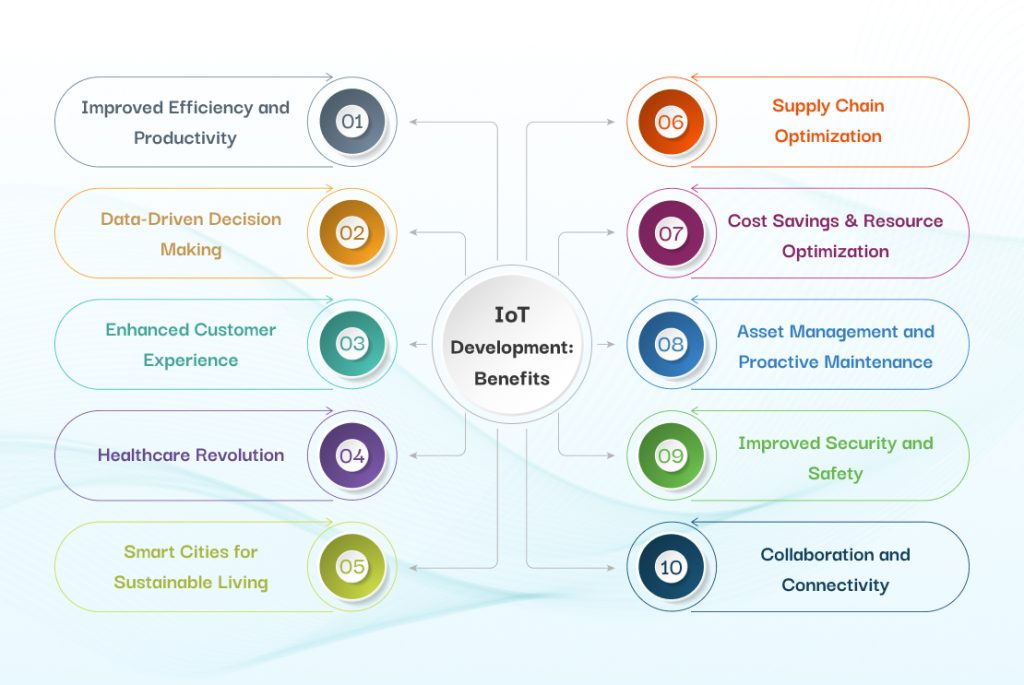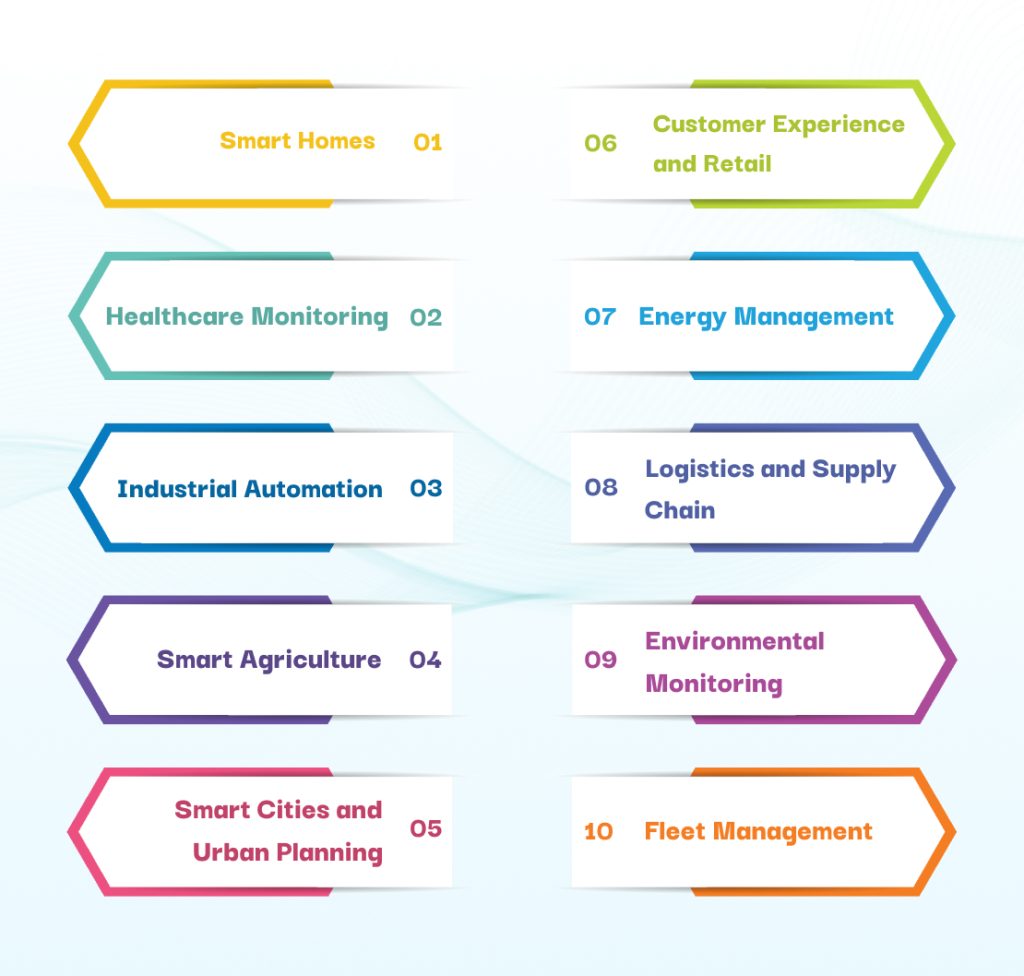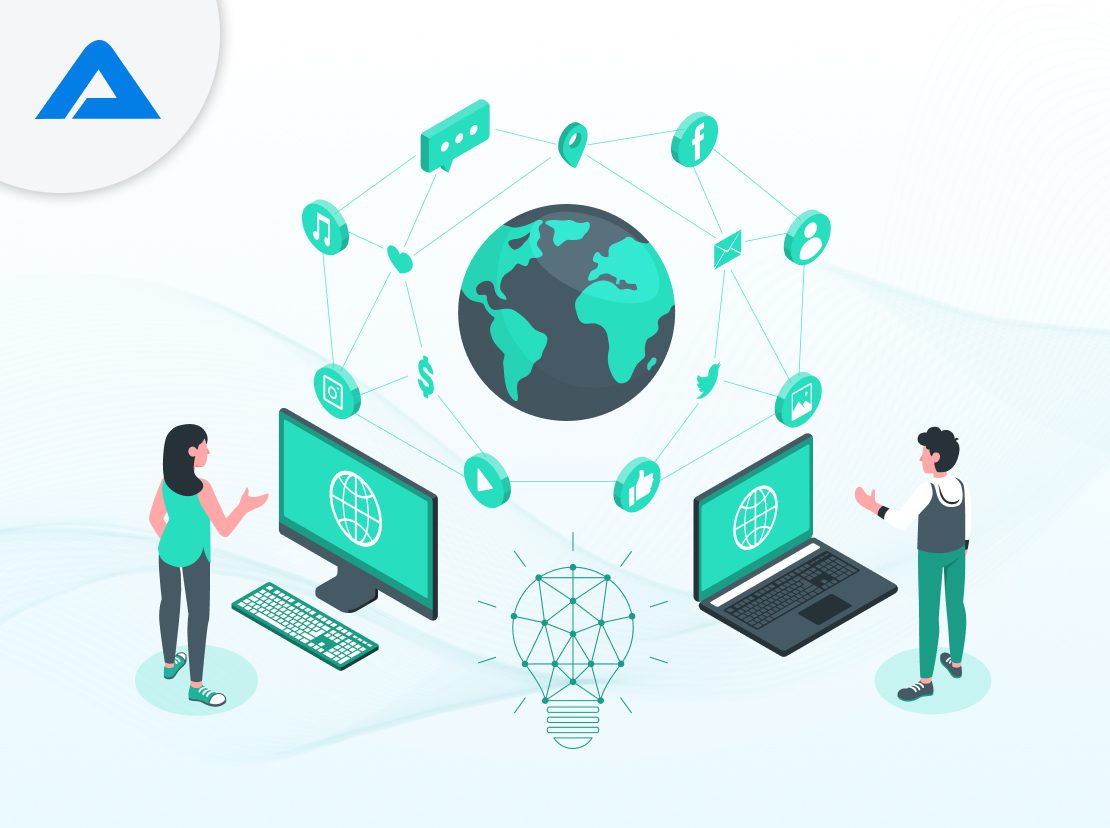The Internet of Things is an incredible force in our digital lives, creating connectivity in everyday activities. IoT innovation and possibilities are abounding as we look forward to the exciting horizon of 2024.
This blog explores the heartbeat of IoT. It examines the industry trends and looks into a crystal ball to determine the direction IoT will take by 2024. IoT app development range from smart cities and connected homes to industrial automation, healthcare services, and much more, revolutionizing how people live, interact, and work.
Join us as we discover IoT trends and technology innovations shaping our world for tomorrow. This exploration will provide a complete overview of IoT challenges and potential opportunities. It is a thorough look at the IoT future, from AI integration to edge computing, from security concerns to sustainability. As we explore the exciting future of IoT, fasten your seatbelts.
IoT Development: Benefits

Here are some of the advantages that IoT can bring:
Improved Efficiency and Productivity
IoT allows for the development of intelligent systems that optimize processes and reduce waste. They also increase productivity. Businesses can collect real-time information by integrating sensors and devices. They can make quick, informed decisions.
In manufacturing, IoT-enabled machines can communicate, streamlining processes and minimizing downtime. Efficiency gains translate not only into cost reductions but also make businesses more agile and competitive.
Data-Driven Decision Making
One significant benefit of IoT technology lies in access to massive amounts of information generated by connected devices – an invaluable source of intelligence that organizations can draw upon for making more informed decisions.
Data collected by IoT devices can be utilized to analyze consumer behaviors, monitor equipment performance, or predict maintenance needs. This intelligence empowers businesses with helpful information. The data-driven strategy allows organizations to adapt to market changes, stay on top of trends, and make strategic decisions.
Enhanced Customer Experience
IoT is essential to improving customer experience across all industries. IoT has transformed how businesses engage with consumers, from smart homes, which allow owners to remotely control their appliances, to retail environments personalizing shopping experiences according to customer preferences.
Companies can customize their services and products to suit individual customer needs by leveraging the data collected from IoT devices. This will increase satisfaction and loyalty among customers.
Healthcare Revolution
IoT is a game changer in the healthcare sector. Wearables and connected medical devices enable healthcare professionals to monitor patients continuously, providing them with data in real-time on vital signs.
The proactive nature of this approach allows early diagnosis, individualized treatment plans, and better patient outcomes. IoT app development services also support remote patient monitoring, reducing the burden placed on hospitals and fostering a patient-centric model.
Smart Cities for Sustainable Living
IoT is an integral part of the development of smart cities. Interconnected systems and devices work in harmony to improve urban life. IoT technology is driving efficiency and sustainability in cities. From intelligent traffic management systems to reduce congestion to solutions for waste management that optimize routes according to the fill level of containers.
Initiatives for smart cities also include energy management, safety in the public, and resource usage, which contribute to a more resilient and sustainable future.
Supply Chain Optimization
Integrating IoT into supply chain management will bring transparency, efficiency, and traceability to the process. Businesses can use RFID and sensors to track the inventory and monitor real-time movement.
This visibility allows better forecasting of demand, improved inventory management, and an overall optimization of supply chains. The result is that organizations can reduce costs, increase delivery time, and improve the reliability of their operations.
Cost Savings & Resource Optimization
IoT can reduce costs by maximizing resource use and decreasing waste. IoT sensors like those used in agriculture can track soil conditions, weather patterns, and crop health. This allows farmers to improve irrigation, pest control, and fertilization. It not only increases crop yields, but it also reduces the use of resources and lowers costs.
In energy management, IoT-enabled systems can optimize electricity consumption in buildings. It results in a reduction of energy costs and an improvement in the environment.
Asset Management and Proactive Maintenance
IoT software development allows businesses to shift from reactive maintenance to proactive strategies. Sensors can monitor assets in real-time and alert organizations when they need care. Predictive maintenance helps to reduce downtime, prevent unplanned breakdowns, and extend the life of equipment. Managing downtime in manufacturing can be costly.
Improved Security and Safety
IoT enhances security and safety in many domains. Sensors can be used in the industrial sector to detect abnormalities and prevent accidents. They also ensure a safe working environment. Smart homes have IoT security systems that provide alerts and real-time monitoring, contributing to residents’ safety.
In addition, IoT-integrated surveillance systems in public places enhance the security of cities and their residents.
Collaboration and Connectivity
IoT technology development promotes connectivity, not just between devices but between companies, industries, and communities. IoT’s interconnectedness allows for collaboration at a larger scale. This leads to new solutions and resources being shared. The interconnectedness of IoT is most evident in the logistics and transportation industries, where data can be transferred to improve efficiency, optimize routes, and reduce congestion.
IoT Development: Use Cases

The applications below demonstrate the flexibility and practical implications of IoT.
Smart Homes
IoT has revolutionized the smart home industry, allowing homeowners to design intelligent, interconnected spaces. IoT is a revolution in the world of smart homes. It has enabled homeowners to create thoughtful and connected living spaces.
Smart locks and surveillance cameras are part of a connected home security system that allows homeowners to monitor and control their homes in real-time.
Healthcare Monitoring
IoT has impacted the healthcare industry significantly. It introduced a new care age with data-driven insights and continuous monitoring. Sensors in wearable devices can monitor vital signs and activity levels. They can also detect abnormalities.
It not only allows for proactive care, but it also gives healthcare providers the ability to monitor their patients remotely. This reduces the frequency of hospital visits. IoT is used in the healthcare industry to monitor medication compliance, create personalized treatment plans, and provide telehealth services.
Industrial Automation
IoT is vital to the industrial world, allowing for process optimization through real-time monitoring and automation. Sensors on equipment and machinery collect data to allow for predictive maintenance and minimize downtime.
IoT app development for industrial environments includes inventory tracking, supply chain management, and quality control. The interconnectedness of IoT applications improves productivity, lowers costs, and increases operational efficiency.
Smart Agriculture
IoT offers agricultural solutions that increase crop yields, decrease resource consumption, and encourage sustainable farming. Sensors in the soil provide farmers with real-time information on their soil’s moisture and nutrient content. This allows them to maximize irrigation and fertilization.
Drones with IoT can be used to monitor the health of crops, detect pest infestations, and evaluate overall conditions on the field. The data-driven agriculture approach contributes to improved decision-making and crop management.
Smart Cities and Urban Planning
IoT is a critical component in creating smart cities. Interconnected systems and devices are essential to urban life. Smart traffic systems use sensors and cameras to monitor traffic flow and signal timings.
IoT-enabled waste management systems optimize collection routes based on the filling level. This leads to more sustainable and efficient practices. Smart street lights adjust brightness according to environmental conditions. This promotes energy savings in urban areas.
Customer Experience and Retail
IoT allows retailers to offer seamless and personalized shopping experiences. Retailers can track their inventory using real-time RFID tags and beacons, which helps prevent stockouts.
Retail IoT also includes smart shelves that automatically update stock levels and promotions based on location delivered directly to customers’ phones. The innovations improve the customer’s experience, making shopping and tailoring their preferences more convenient.
Energy Management
IoT is essential in energy management, as it allows businesses and consumers to optimize and monitor their energy usage. Thermostats, lighting, and other smart home appliances can be programmed to save energy and be controlled remotely. IoT sensors can track energy consumption in industrial settings and pinpoint areas that need optimization.
IoT application development company uses smart grids to enable a more efficient distribution, reducing wastage and promoting energy system sustainability.
Logistics and Supply Chain
IoT has revolutionized logistics by allowing real-time tracking of the flow of goods. Trackers and sensors with GPS capabilities monitor the condition and location of goods, which allows for accurate tracking and on-time delivery.
IoT applications for supply chain optimization can include tracking inventory, route optimization, and predictive maintenance of vehicles and equipment. The result is reduced operating costs, faster delivery, and improved efficiency.
Environmental Monitoring
IoT contributes to conserving environmental resources through applications such as air and water monitoring. Sensors in urban areas measure pollution, giving environmental authorities valuable information to reduce pollution levels.
In the same way, IoT-enabled devices installed in natural ecologies can monitor changes in biodiversity, environmental conditions, and wildlife movement—these data aid in researching environmental issues, conservation, and sustainable practice development.
Fleet Management
IoT plays an essential role in the fleet management of transportation companies. The combination of GPS tracking and sensors in vehicles allows for real-time monitoring. Fleet managers can use these data to optimize routes and plan maintenance. They also help them comply with safety standards. IoT in fleet management can improve operational efficiency, cost reductions, and increased safety.
IoT Development: Trends and Predictions for Future
The key IoT trends are listed below. Make predictions about the impact of these innovations on industry and everyday life.
Edge Computing Dominance
The data volume produced by IoT devices is increasing, and the need for processing and analysis is growing. The edge computing trend, where data is processed closer to its source rather than using centralized servers for processing, has become a significant force in IoT.
This reduces network latency and increases real-time computing capabilities. It also relieves strain on the bandwidth. Edge computing will be increasingly popular in the future. This is especially true for applications requiring rapid decision-making, like autonomous vehicles or smart city infrastructure.
Acceleration of 5G Integration
The adoption of 5G is critical to the rapid development of IoT. The 5G network’s low latency and high-speed capabilities enable seamless connectivity of many IoT devices. The integration of 5G is expected to bring about a new wave of innovation across sectors such as healthcare, manufacturing, and smart cities.
Increased bandwidth and lower latency in 5G networks enable complex IoT apps, improving user experience and efficiency.
Artificial Intelligence and Machine Learning (ML) Integration
Synergy of IoT with artificial intelligence is the trend that will shape IoT’s future. The vast IoT datasets will fuel machine learning algorithms that allow systems to adapt and learn in real-time. The capabilities of IoT app development services will be enhanced by more advanced predictive analytics and anomaly detectors.
AI integration will bring new dimensions to efficiency and innovation, from predictive maintenance for industrial settings to personalized healthcare recommendations.
Related Article:- Artificial intelligence in software development
Security Focus Intensification
Security will become increasingly crucial as IoT ecosystems grow more complex and interconnected. Cybersecurity breaches or unauthorized access to IoT devices present a significant hurdle.
Future IoT designs should focus heavily on robust security measures such as end-to-end cryptography, device authentication, and regular updates to security patches. Blockchain technology will also be used for identity verification and secure data transfers, which is expected to increase in popularity. This ensures the confidentiality and integrity of IoT data.
Green IoT and Sustainability
IoT will be more focused on environmental awareness and sustainability in the future. Green IoT will strive to reduce the environmental impact of devices and networks connected. It includes designing energy-efficient hardware, optimal resource usage, and integrating renewable energy sources.
IoT sustainable practices will reduce carbon footprint and align global efforts to build a resilient, environmentally-friendly future.
Rise of IoT in Healthcare
IoT is set to revolutionize the healthcare sector. Remote patient monitoring devices, wearables, and smart medical equipment will increase, allowing continuous tracking and personalized health plans.
IoT will be used in healthcare to improve medication adherence and chronic disease management. It will also help detect health problems early. IoT integration in healthcare will improve patient outcomes, lower healthcare costs, and increase the accessibility of medical services.
Data Integrity with Blockchain
Blockchain technology will be essential to the IoT system’s data integrity. Blockchain’s decentralized, tamper-resistant nature is ideal for storing and transacting data that has become increasingly sensitive and valuable.
Blockchain can improve the transparency, reliability, and traceability of data. This will help address data manipulation, unauthorized access, and data manipulation concerns.
Augmenting Human Performance with the Internet of Things
IoT software development will go beyond the devices and include human enhancement, improving our cognitive abilities. The wearables, brain-computer interfaces, and implantable technologies will become even more advanced, allowing for personalized health monitoring and enhancing human capabilities. The trend offers new possibilities in terms of improved communication and accessibility.
Cross-Industry Cooperation
IoT will be characterized by increased collaboration between industries to develop comprehensive solutions in the future. Combining IoT technology with robotics, artificial intelligence, and augmented realities to produce innovative solutions is an invaluable way for manufacturers, logistics providers, and customer service departments to stay ahead of the competition in today’s highly connected economy.
Collaboration between businesses, technology providers, and government will create IoT ecosystems capable of solving complex issues seamlessly.
Regulatory Framework Maturation
As the IoT ecosystem matures, privacy, security, and data interoperability regulations will be developed in response to new challenges. The governments and regulatory agencies will take a more significant role in shaping responsible and ethical IoT technology development. The standardization effort will foster interoperability between diverse IoT systems and devices, creating a cohesive IoT ecosystem.
Conclusion
Looking into the future, we see a blaze of transformative opportunities that will redefine how we live in an increasingly connected world. Trends and predictions from 2024 onwards herald an era of technology innovation where edge computing, artificial intelligence, and 5G integration will unleash unprecedented capabilities.
Edge computing is a sign of a move towards decentralized processing. This ensures real-time decisions and reduces latency. In parallel, 5G network integration accelerates seamless connectivity and enables various IoT apps to flourish across industries. The synergy of IoT with artificial intelligence is a powerful force that propels predictive analytics and customized experiences to new levels.
The security of IoT application development company is a significant concern. This will be addressed by focusing on solid measures. Green IoT initiatives are aimed at minimizing environmental impact and promoting eco-friendly methods.
IoT-based applications are transforming the healthcare industry, allowing personalized treatments and continuous monitoring. The maturation of IoT regulatory frameworks shows all commitment to ethical and responsible IoT.
On this journey we are embarking upon, we aim to build a more connected, smart, and sustainable world using IoT as its cornerstone of innovation and progress. There are endless possibilities presented by the Internet of Things’ innovative path. Its rise will become part of an evolving digital landscape in time.
